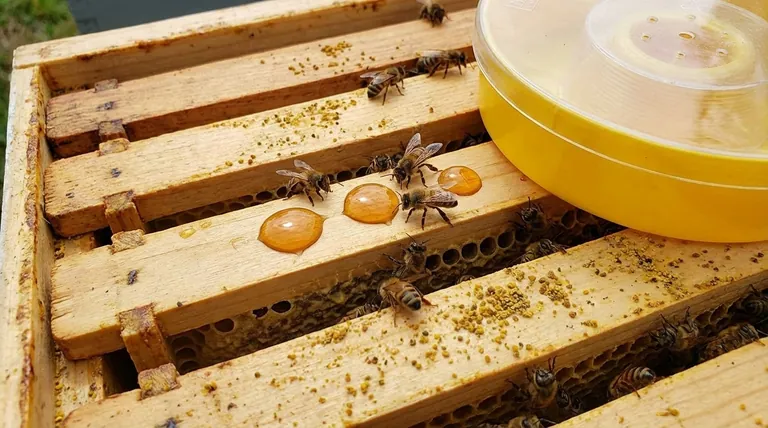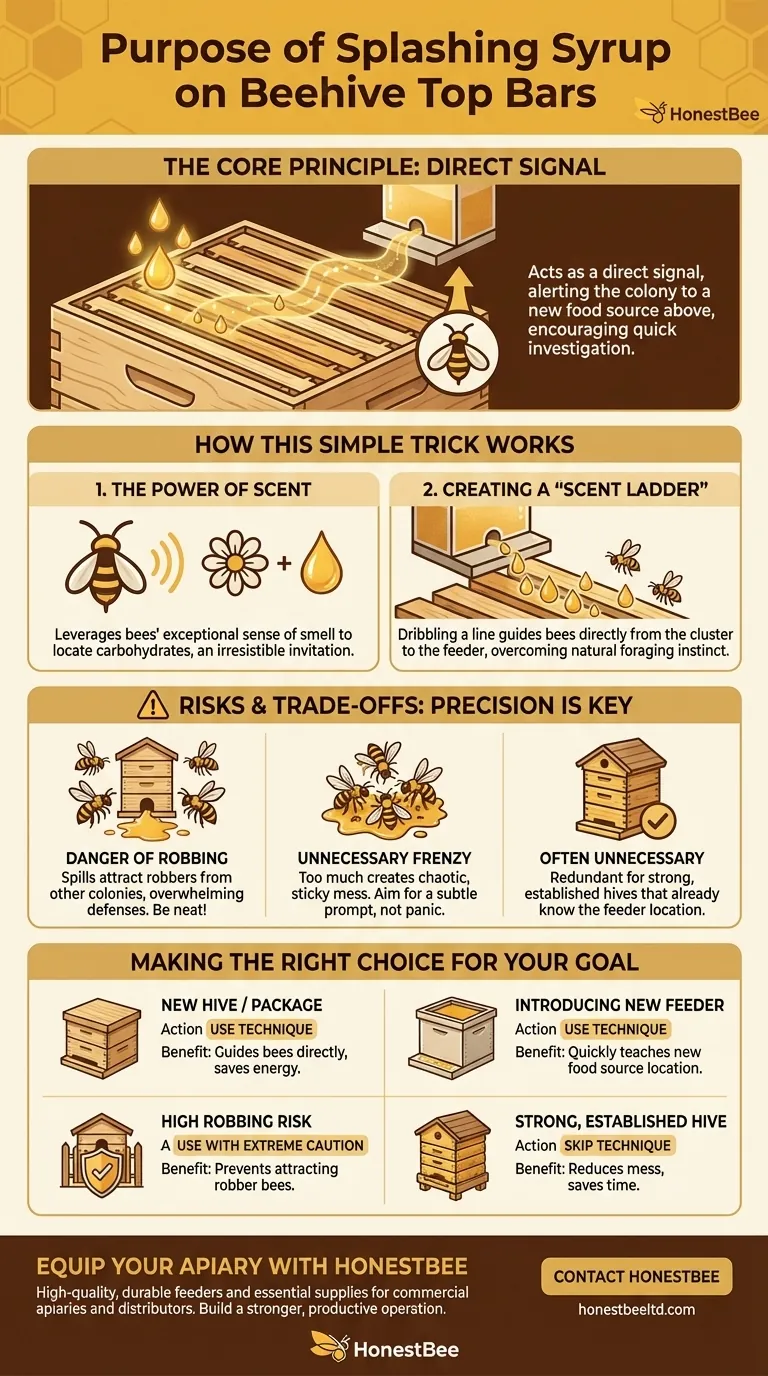Splashing a few drops of syrup on the top bars serves one primary function: it acts as a direct signal to the bees. This simple action alerts the colony that a new food source is available directly above them, encouraging them to investigate and quickly locate the feeder.
The core principle is communication. You are creating a scent trail that guides the bees from their cluster to the feeder, overcoming their natural inclination to look for food outside the hive.

How This Simple Trick Works
To understand why this is effective, you need to think like a bee. A honeybee colony is a highly organized system that relies on clear signals and efficient foraging to survive.
The Power of Scent
Bees have an exceptional sense of smell, which they use to locate nectar-rich flowers miles away from the hive. Splashing sugar syrup onto the top bars leverages this powerful instinct.
The aroma of the syrup wafts down into the brood nest, immediately signaling the presence of carbohydrates. This scent acts as an irresistible invitation, especially if outside food sources are scarce.
Creating a "Scent Ladder"
When you place a feeder on top of a hive, particularly a new or weak colony, the bees may not realize it's there. They are biologically programmed to exit the hive to forage.
Dribbling a small line of syrup from the feeder opening down to the top bars creates a "scent ladder." The first bees to discover this trail will follow it directly to the source, and their success will quickly be communicated to the rest of the colony.
Understanding the Trade-offs and Risks
While this technique is simple and effective, it is not without risks. Precision and awareness are key to preventing unintended consequences that could harm your hive.
The Danger of Robbing
Spilled syrup is the number one cause of robbing behavior. If you spill syrup on the outside of the hive or on the ground, it can attract foragers from other, stronger colonies.
These robbing bees can overwhelm your hive's defenses, stealing all their winter stores and potentially killing the queen. It is critical to be neat and ensure all syrup is contained within the hive.
Creating Unnecessary Frenzy
A "few drops" is the operative phrase. Dousing the top bars with a large amount of syrup can create a frantic mess.
This can lead to bees getting covered in sticky syrup, which can be fatal. It also creates a chaotic environment that is stressful for the colony. The goal is a subtle prompt, not a sugar-induced panic.
It's Often Unnecessary
For a strong, established hive that has used the same feeder in previous seasons, this step is often redundant. The bees already know where the feeder is and will find it on their own once it's filled. This technique is most valuable for new or struggling colonies.
Making the Right Choice for Your Goal
Use this technique as a targeted tool, not a routine habit. Your goal will determine if and how you should apply it.
- If your primary focus is introducing a new feeder: Always use this technique to ensure the bees learn the location of the new food source quickly.
- If your primary focus is feeding a weak hive or new package: This is a crucial step to give them immediate access to nutrition without wasting energy searching.
- If your primary focus is preventing robbing: Be exceptionally careful, using only a minimal amount of syrup and immediately cleaning any external spills.
- If your primary focus is feeding a strong, established hive: This step is likely unnecessary and can be skipped to save time and reduce mess.
Ultimately, this small action is a powerful way to communicate with your bees and guide them toward the resources you provide.
Summary Table:
| Situation | Recommended Action | Key Benefit |
|---|---|---|
| New Hive / Package Bees | Use the technique | Guides bees directly to food, saving energy. |
| Introducing a New Feeder | Use the technique | Quickly teaches the colony the new food source location. |
| Strong, Established Hive | Skip the technique | Bees already know where the feeder is; reduces mess. |
| High Risk of Robbing | Use with extreme caution | Prevents attracting robber bees from other colonies. |
Ensure your bees find their food efficiently with the right equipment. HONESTBEE supplies commercial apiaries and beekeeping equipment distributors with high-quality, durable feeders and essential beekeeping supplies through our wholesale-focused operations. Let us help you build a stronger, more productive operation. Contact HONESTBEE today to discuss your needs!
Visual Guide

Related Products
- HONESTBEE Round Hive Top Bee Feeder for Syrup
- Boardman Entrance Bee Feeder Durable Galvanized Steel and Wood Construction for Beekeeping
- Rapid Bee Feeder White Plastic 2L Round Top Feeder for 8 or 10-Frame Bee Hives
- HONESTBEE Entrance Bee Feeder Professional Hive Nutrition Solution for Beekeeping
- Classic Boardman Entrance Bee Feeder Hive Front Feeding Solution
People Also Ask
- How do you set up and use a top feeder for bees? A Step-by-Step Guide for Safe Feeding
- What features make top feeders a reliable choice for beekeepers? A Guide to Safe, Efficient Hive Nutrition
- How do hive top feeders work? A Guide to Efficient, High-Capacity Bee Feeding
- What can the round hive top feeder be used for? A Guide to Efficient, Safe Bee Feeding
- How should syrup for bees be prepared? Master the Ratio for a Thriving Hive



















